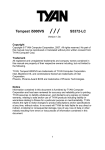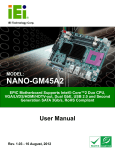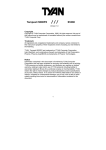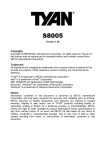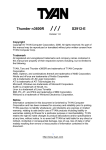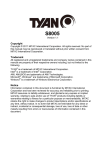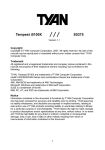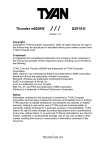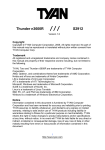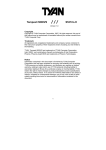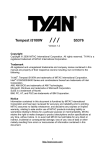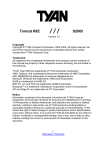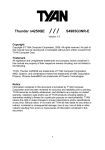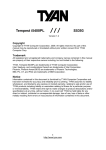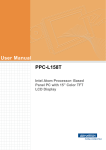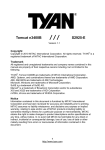Download Tyan S5397WAG2NRF motherboard
Transcript
Tempest i5400PW /// S5397 Version 1.3 Copyright Copyright © 2008 MiTAC International Corporation. All rights reserved. TYAN is a registered trademark of MiTAC International Corporation. Trademark All registered and unregistered trademarks and company names contained in this manual are property of their respective owners including, but not limited to the following. TYAN, Tempest i5400PW are trademarks of MiTAC International Corporation. Intel, Dual-Core Xeon 5100/5200 Series, Quad-Core Xeon 5300/5400 Series and combinations thereof are trademarks of Intel Corporation in the U.S. and other countries. Microsoft, Windows, and the Windows logo are trademarks, or registered trademarks of Microsoft Corporation in the United States and/or other countries. TM Phoenix, Phoenix Technologies and Phoenix Award are trademarks and/or registered trademarks of Phoenix Technologies Ltd. Notice Information contained in this document is furnished by MiTAC International Corporation and has been reviewed for accuracy and reliability prior to printing. MiTAC assumes no liability whatsoever, and disclaims any express or implied warranty, relating to sale and/or use of MiTAC products including liability or warranties relating to fitness for a particular purpose or merchantability. MiTAC retains the right to make changes to product descriptions and/or specifications at any time, without notice. In no event will MiTAC be held liable for any direct or indirect, incidental or consequential damage, loss of use, loss of data or other malady resulting from errors or inaccuracies of information contained in this document. 1 http://www.tyan.com Table of Contents Check the box contents! Chapter 1: Introduction 1.1 Congratulations 1.2 Hardware Specifications Chapter 2: Board Installation 2.1 Board Image 2.2 Block Diagram 2.3 Board Parts, Jumpers and Connectors 2.4 Tips on Installing Motherboard in Chassis 2.5 Installing the Processor(s) 2.6 Installing the Memory 2.7 Attaching Drive Cables 2.8 Installing Add-in Cards 2.9 Installing Optional SO-DIMM Modules 2.10 Connecting External Devices 2.11 Installing the Power Supply 2.12 Finishing up Chapter 3: BIOS Setup 3.1 About the BIOS 3.2 BIOS Main Menu 3.3 Advanced Menu 3.4 Security Menu 3.5 Power Menu 3.6 Boot Menu 3.7 Exit Menu Chapter 4: Diagnostics 4.1 Beep Codes 4.2 Flash Utility 4.3 Phoenix BIOS Post Code Appendix: SMDC Information Glossary Technical Support 2 http://www.tyan.com 3 5 5 8 9 10 20 21 27 30 32 33 34 35 35 37 39 46 61 62 63 64 65 65 66 69 71 79 Check the box contents! 1x S5397 motherboard 1x 34-Pin floppy drive cable 1 x Ultra-DMA-133/100/66/33 IDE cable 3 x Serial ATA power cable 6 x Serial ATA cable 1 x COM Port cable 2 x mini SAS Cable (S5397WAG2NRF only) 1 x 12V Power Y-cable 1x USB Y-cable 1 x IEEE1394a cable 1 x Audio cable (optional, MiTAC P/N # 422774700001) 1 x S5397 user’s manual 1 x S5397 Quick Reference guide 1 x TYAN driver CD 1 x I/O shield 2 x CPU CEK (pre-installed) 1 x CPU heatsink mounting plate kit If any of these items are missing, please contact your vendor/dealer for replacement before continuing with the installation process. 3 http://www.tyan.com NOTE 4 http://www.tyan.com Chapter 1: Introduction 1.1 - Congratulations You have purchased one of the most powerful server solutions. The Tempest i5400PW (S5397) is a flexible Intel® platform for multiple applications, based on ® Intel i5400B (Seaburg-1600) MCH and 6321ESB chipsets. Designed to support two Intel® Dual-Core Xeon® 5100/5200 Series, Quad-Core Xeon® 5300/5400 Series processors, and max 128GB DDR2-533/667/800 FBDIMM memory, and featured with integrated Gigabit Ethernet LAN and four SATA2 ports, the S5397 offers exceptional performance and versatile solution for your server platform. Remember to visit TYAN’s Website at http://www.tyan.com. There you can find information on all of TYAN’s products with FAQs, online manuals and BIOS upgrades. 1.2 - Hardware Specifications Processors • Dual LGA771 sockets • Supports up to two Dual-Core Intel® Xeon® 5100/5200 Series, Quad® Core Intel Xeon 5300/5400 Series processors • 1066/1333/1600 MT/s system bus • VRD 11.0 Chipset • Intel® i5400B (Seaburg-1600) MCH + 6321ESB chipset • Supports for 1066/1333/1600 MT/s system bus • Winbond 83627HF super I/O chip Expansion Slots • Two (2) PCI Express x16 slots (w/ x16 PCI-E Gen2 signals) from MCH • One (1) PCI Express x8 slot (w/ x4 signals) • Two (2) PCI-X 133/100MHz slots • One (1) PCI 32/33MHz slot (PCI device component height limit = 9.2mm) • Six expansion slots in total Integrated SATA II/SAS • Six (6) SATA2 ports from Intel ESB2 - Integrated RAID 0, 1, 5, and 10 support under windows • LSI 1068E SAS controller with PCIE x8 interface (S5397WAG2NRF only) - Two (2) mini SAS (4 in 1) connectors - RAID 0, 1 and 1E support Integrated 2D PCI Graphics • XGI Z9S • PCI interface • 32MB DDR2 memory Integrated Audio • Realtek ALC262 audio CODEC • HDA 2.0 specification compliant • 2 x 5 pin header for front panel audio connector • CD-in connector • Optional audio cable for rear panel audio jack 5 http://www.tyan.com Memory • Sixteen (16) 240-pin DDR2 FBDIMM* sockets on board • Maximum of 128GB DDR2533/667/800 • Supports 1.8V FB-DIMM • Supports 1.5V or 1.8V FB-DIMM on Rev. 03 and beyond (without mixuse of 1.5V and 1.8V FB-DIMM) *FB-DIMM: Fully Buffered DIMM Integrated I/O Interface • One (1) IDE port • One (1) floppy port • Two (2) USB2.0 ports via cable • Two (2) Mini SAS (4 in 1) connectors (S5397WAG2NRF only) • Six (6) SATA2 connectors • One (1) COM2 header • One (1) 2x9 pin TYFP header • One (1) 2x6 pin TYFP2 header (for TYAN barebone) • One (1) 2x7 pin FAN header (for TYAN barebone) • One (1) 3x2 pin LCD module header • Two (2) 2x5 pin 1394 header Back Panel I/O Ports • One (1) stacked PS/2 mouse and keyboard connectors • One (1) stacked USB2.0 x 2 ports • One (1) 9-pin serial port • One (1) 15-pin VGA port • Two (2) stacked RJ-45 x2 LAN ports + one (1) RJ-45 Form Factor • Extended ATX (12” x 13”) board size, with proprietary CPU heatsink mounting holes • EPS 12V/SSI (24+8+4+4 pin) power connectors for 5x +12V input Trusted Platform Management (TPM) • Infineon SLB9635TT 1.2 Server Management • Supports Server Management • TYAN SMDC M3295-2/M3296 support (SMDC card is optional) System Management • Winbond W83793G Hardware Monitoring IC • CPU thermal & voltage monitor support • Six (6) 4-pin fan monitoring headers • PECI circuit for Woodcrest / Clovertown / Wolfdale-DP / Harpertown processor thermal monitoring Integrated PCI 1394 • VT6308 PCI FireWire (IEEE1394) controller • Two (2) IEEE1394 headers (via cable) Integrated LAN Controllers • One (x1) Intel Gilgal (82563EB) PHY • Direct link to ESB2 • Two (x2) Gigabit LAN ports • Two front panel LED supported via TYFP2 header BIOS • Phoenix BIOS on 8Mbit Flash ROM • Supports ACPI 1.0b • Serial Console Redirect • PXE via Ethernet, USB device boot • PnP, DMI 2.0 Power Management • User-configurable H/W monitoring • Auto-configuration of hard disk types • Multiple boot options • 48-bit LBA support Regulatory • FCC Class B (DoC) • European Community CE (DoC) 6 http://www.tyan.com Chapter 2: Board Installation You are now ready to install your motherboard. Before continuing with installation, confirm that your chassis supports SSI EEB 3.6 and beyond specification with removable stand-offs. The mounting hole pattern of the Tempest i5400PW (S5397) is proprietary, and we supply CPU mounting plates to support an SSI EEB 3.6 compliant chassis. How to install our products right… the first time The first thing you should do is reading this user’s manual. It contains important information that will make configuration and setup much easier. Here are some precautions you should take when installing your motherboard: (1) Ground yourself properly before removing your motherboard from the antistatic bag. Unplug the power from your computer power supply and then touch a safely grounded object to release static charge (i.e. power supply case). For the safest conditions, TYAN recommends wearing a static safety wrist strap. (2) Hold the motherboard by its edges and do not touch the bottom of the board, or flex the board in any way. (3) Avoid touching the motherboard components, IC chips, connectors, memory modules, and leads. (4) Place the motherboard on a grounded antistatic surface or on the antistatic bag that the board was shipped in. (5) Inspect the board for damage. The following pages include details on how to install your motherboard into your chassis, as well as installing the processor, memory, disk drives and cables. NOTE DO NOT APPLY POWER TO THE BOARD IF IT HAS BEEN DAMAGED. 7 http://www.tyan.com 2.1- Board Image This picture is representative of the latest board revision available at the time of publishing. The board you receive may or may not look exactly like the above picture. 8 http://www.tyan.com 2.2 - Block Diagram Tempest i5400PW S5397 Block Diagram 9 http://www.tyan.com 2.3 - Board Parts, Jumpers and Connectors This diagram is representative of the latest board revision available at the time of publishing. The board you receive may not look exactly like the above diagram. Jumper Legend OPEN - Jumper OFF, without jumper cover CLOSED – Jumper ON, with jumper cover 10 http://www.tyan.com Jumper/Connector Function J7/J12/J19/J21/J36/J40 4-pin FAN Connector J3 Onboard HD Audio Header J6 CD_IN Audio Header J8 IPMB Header J20 COM2 Header J22/J23 1394 Header J28 Front Panel Header J33 TYAN Fan speed Header for Barebone J37 TYAN TYFP2 Header (for TYAN Barebone Front Panel) J38 TYAN LCM Header for Barebone J41 USB Front Panel Header P1 Audio Jack Header Aux. Power Header for TYAN Riser Card (M2061) PSMI Connector (Reserved for Barebone) J2 J18 JP1 Clear CMOS Jumper Pin 1-2 closed: Normal (Default) Pin 2-3 closed: Clear JP3 Onboard VGA Disable Jumper Pin 1-2 closed: Enable (Default) Pin 2-3 closed: Disable JP4 Onboard 1394 Disable Jumper Pin 1-2 closed: Enable (Default) Pin 2-3 closed: Disable JP5 PCI-X Speed Select Jumper Pin 1-2 closed: 133MHz (Default) Pin 2-3 closed: 100MHz JP6 Onboard SAS Disable Jumper Pin 1-2 closed: Enable (Default) Pin 2-3 closed: Disable JP7 FBD DIMM Voltage Select Jumper Pin 1-2 closed: 1.5V Pin 2-3 closed: 1.8V (Default) 11 http://www.tyan.com J12 J19 J7 J36 J21 J20 12 http://www.tyan.com J28 J37 J40 J7/J12/J19/J21/J36/J40: 4-pin Fan Connector Use these headers to connect the 4-pin cooling fans 1 to your motherboard to keep the system stable and reliable. These connectors support the tachometer monitoring and auto fan speed control. J7: System Fan J19: CPUFAN0 J21: System Fan PWN CT RL GND TAC H +12 V J12: System Fan J36: CPUFAN1 J40: System Fan J37: TYAN TYFP2 Header for Barebone It is designed for BAREBONE use only. 2 12 1 11 Pin Signal Pin Signal 1 3 5 7 9 11 LAN1 LED+ LAN2 LED+ NC ID LED+ ID SW+ KEY 2 4 6 8 10 12 LAN1 LEDLAN2 LEDNC ID LEDID SWNC J20: COM2 Header Use these pin definitions to connect a port to COM2. 9 10 1 2 Pin Signal Pin Signal 1 3 5 7 9 DCD RXD TXD DTR GND 2 4 6 8 10 DSR RTS CTS RI KEY J28: Front Panel Header 17 1 18 2 The Front Panel Header is used to connect some control or signal wires from motherboard to chassis, such as HDD LED, power LED, power button, and reset button. HDDLED+ HDDLEDGND Reset SW+ GND NMI 5VSB SMBus Data SMBus Clock 1 3 5 7 9 11 13 15 17 13 http://www.tyan.com 2 4 6 8 10 12 14 16 18 PWR LED+ PWR LEDPWR SW+ GND Warning LED+ Warning LEDKEY GND Intruder J2 J41 J38 J8 J33 14 http://www.tyan.com J41: USB Front Panel Header Use these headers to connect to the USB devices via the enclosed USB cable. 2 10 1 9 Pin Signal Pin Signal 1 3 5 7 9 PWR 5V USB_N1 USB_P1 GND KEY 2 4 6 8 10 PWR 5V USB_N2 USB_P2 GND GND J33: Fan Speed Header for Barebone It is designed for BAREBONE use only. 2 14 1 13 Pin Signal Pin Signal 1 3 5 7 9 11 13 FAN1 TACH FAN3 TACH FAN5 TACH FAN7 TACH FAN9 TACH GND GND 2 4 6 8 10 12 14 FAN2 TACH FAN4 TACH FAN6 TACH FAN8 TACH FAN10 TACH KEY PWM SIG J8: IPMB Header 1 Pin Signal Pin Signal 1 3 SDAT SCLK 2 4 GND NC J2: Aux. Power Header for TYAN Riser Card (M2061) 1 Pin Signal Pin Signal 1 3 12V GND 2 4 GND 5V 5V 12 V GND G ND J38: LCM Header for Barebone It is designed for BAREBONE use only. 6 2 5 1 Pin Signal Pin Signal 1 3 5 VCC5 KEY VCC5SBY 2 4 6 RXD GND TXD 15 http://www.tyan.com P1 J3 SATA4 SATA3 SATA5 SATA2 J23 J6 J22 16 http://www.tyan.com SATA1 SATA0 J3: Onboard HD Audio Header 2 10 1 9 TYAN does not provide cables for this header. The audio cable comes along with the 3rd party chassis supporting front audio jack module. Pin Signal Pin Signal 1 3 5 7 9 MIC_L MIC_R LINE_R SENSE LINE_L 2 4 6 8 10 GND PRESENT MIC_JD KEY LINE_JD SATA0/1/2/3/4/5: SATA RAID Connector Connects to the Serial ATA ready drives via the Serial ATA 7 cable. Pin 1 Pin 2 Pin 3 Pin 4 Pin 5 Pin 6 Pin 7 GND TXP TXN GND RXN RXP GND 1 J6: CD_IN Audio Header 4 TYAN does not provide cables for this header. 1 Pin Signal Pin Signal 1 3 CD_R CD_GND 2 4 CD_GND CD_L P1: Audio Jack Header 1 11 Optional audio cable for rear panel audio jack is available for order (MiTAC P/N# 422774700001). 2 12 Pin Signal Pin Signal 1 3 5 7 9 11 MIC_L GND LINE-IN_L KEY LINE-OUT_L NC 2 4 6 8 10 12 MIC_R MIC_JD LINE-IN_R LINE-IN_JD LINE-OUT_R LINE-OUT_JD J22/J23: IEEE1394 Header 2 10 1 9 Pin Signal Pin Signal 1 3 5 7 9 XTPAP GND XTPBP PWR 12V KEY 2 4 6 8 10 XTPAM GND XTPBM PWR 12V GND 17 http://www.tyan.com J18 JP1 JP7 JP5 JP3 JP4 JP6 JP7: FBD DIMM Voltage Select Jumper (Rev. 03 and beyond) 1 3 Pin 1-2 Closed: 1.5V 1 3 Pin 2-3 Closed: 1.8V (Default) NOTE: Do not mix 1.5V and 1.8V FB-DIMMs in one system. 18 http://www.tyan.com J18: PSMI Connector for Barebone 5 1 It is designed for BAREBONE use only. Pin Signal Pin Signal 1 3 5 SMBCLK RSVD VCC3 2 4 SMBDAT GND JP1: Clear CMOS Jumper 1 3 Normal (Default) 1 3 Clear Use this jumper when you have forgotten your system/setup password or need to clear the system BIOS settings. How to clear the CMOS data: Power off system and disconnect the power supply from the AC source Use jumper cap to close Pin 2 and 3 for several seconds to Clear CMOS Replace jumper cap to close Pin 1 and 2 Reconnect the power supply to the AC source Power on system JP3: Onboard VGA Jumper 1 Pin 2-3 Closed: Disable 3 1 Pin 1-2 Closed: Enable (Default) 3 JP4: Onboard 1394 Jumper 1 3 Pin 1-2 Closed: Enable (Default) 1 3 Pin 2-3 Closed: Disable JP5: PCI-X Speed Select Jumper 1 3 Pin 2-3 Closed: 100MHz 1 3 Pin 1-2 Closed: 133MHz (Default) JP6: Onboard SAS Jumper 3 Pin 1-2 Closed: Enable (Default) 1 3 Pin 2-3 Closed: Disable 1 19 http://www.tyan.com 2.4 - Tips on Installing Motherboard in Chassis Before installing your motherboard, make sure your chassis has the necessary motherboard support studs installed. These studs are usually metal and are gold in color. Usually, the chassis manufacturer will pre-install the support studs. If you are unsure of stud placement, simply lay the motherboard inside the chassis and align the screw holes of the motherboard to the studs inside the case. If there are any studs missing, you will know right away since the motherboard will not be able to be securely installed. Some chassis’ include plastic studs instead of metal. Although the plastic studs are usable, TYAN recommends using metal studs with screws that will fasten the motherboard more securely in place. Below is a chart detailing what the most common motherboard studs look like and how they should be installed. 20 http://www.tyan.com 2.5 - Installing the Processor(s) Your Tempest i5400PW S5397 supports the latest processor technologies from Intel. Check the TYAN website (http://www.tyan.com) for latest processor support. The Tempest i5400W S5397 is extended ATX form factor with proprietary CPU heatsink mounting hole locations. We provide the CPU heatsink mounting plate kit for users to adopt SSI EEB-3.51-and-beyond compliant chassis. CPU Heatsink Mounting Plate Installation The CPU mounting plate kit should be installed to the chassis before you screw the mainboard to the chassis. Make sure you are wearing an antistatic strap and handle the components as careful as possible. Follow these instructions to install the CPU heatsink mounting plate. 1. Locate the 8 SSI EEB CPU heatsink mounting holes on chassis base. 2. Align the CPU heatsink mounting plate with 8 SSI EEB CPU heatsink mounting holes on the chassis base, and fasten it with the flat screws in the CPU heatsink mounting plate kit. 21 http://www.tyan.com 3. There are 3 types of stand-offs included in S5397 CPU heatsink mounting plate kit to match different height of chassis stand-offs. They are 4mm-high, 5mm-high and 6mm-high (from left to right). 4. Select the most suitable stand-off for your chassis, and fasten them onto the CPU heatsink mounting plate. They are the stand-offs to which you mount CPU heatsink later. Chassis Stand-off Height 3.5mm – 4.5mm 4.5mm – 5.5mm 5.5mm – 6.5mm Mounting Plate Stand-off Height 4mm 5mm 6mm 22 http://www.tyan.com 5. Take out the black mylar (P/N: 346772500002) from motherboard accessories. Remove the adhesive cover and place it on top of the CPU heatsink mounting plate. 6. Install the mainboard into the chassis. Align CPU heatsink mounting holes with 8 stand-offs on the CPU heatsink mounting plate. 7. Follow the processor installation process to install CPU(s). Place the CPU heatsink(s) on top of CPU(s) and fasten CPU heatsink(s) with screws. 23 http://www.tyan.com Processor Installation (LGA771 Socket) The processor should be installed carefully. Make sure you are wearing an antistatic strap and handle the processor as little as possible. Follow these instructions to install your processor. 1. Locate the processor socket on the motherboard and lift the protective cover off as shown. WARNING: This new processor socket designed by Intel is easy to be damaged. The processor has to be installed very carefully to prevent the contact pins of the socket from breaking. It is strongly recommended the processor installation job to be handled by the experienced technician. 2. Pull the locking lever out of it’s locked position and let it spring into the open position. 3. Lift the metal cover to expose the socket interior and place the socket in as shown. Pin 1 24 http://www.tyan.com 4. Close the cover and return the locking lever to its locked position. 5. Repeat this procedure for the second processor socket. 6. Turn the board upside down and insert the heat sink spring mechanism as shown. 7. Turn the board the right way up again and screw the heat sink into place. 25 http://www.tyan.com 8. Repeat this procedure for the second processor. Cooling Fan Installation After you have installed the processor, the heatsink should be installed to ensure that the processor runs efficiently and does not overheat. Use the heatsink supplied for best results. Follow these instructions to install the heatsink shown. 1. 2. 3. 4. Apply some (a little will work, more doesn’t equal better performance) thermal compound to the top of the processor. Try and apply a thin, even layer over the top of the processor. Align the heatsink with the four holes around the processor socket. Press the heatsink down until the four screws are securely seated in the holes. Use screw drive to secure the four screws. 26 http://www.tyan.com 2.6 - Installing the Memory Before installing memory, ensure that the memory you have is compatible with the motherboard and processor. Only DDR2-800/667/533 Fully Buffer DIMM (FB DIMM) modules are required. Check the TYAN Web site at: www.tyan.com for details of the type of memory recommended for your motherboard. The following diagram shows common types of FB-DIMM memory modules. Key points to note before installing memory: • • • • • • Only DDR2 800/667/533 FB-DIMM memory modules are supported. All installed memory will automatically be detected and no jumpers or settings need changing. The Tempest i5400PW S5397 supports up to 128GB of memory. DDR2 533 FB-DIMM memory modules are NOT supported with FSB-1600 processors. DDR2 667 FB-DIMM memory modules will operate at 640MHz frequency with FSB-1600 processors. All memory must be of the same type and density. Please refer to the table below for supported CPU FSB and DIMM Frequency combinations. CPU FSB DIMM Module DDR2-533 DDR2-667 DDR2-800 1066FSB 1333FSB 1600FSB 533MHz 667MHz 667MHz 533MHz 667MHz 667MHz Not Supported 640MHz 800MHz 27 http://www.tyan.com The following chart outlines the suggested rules for populating memory. Memory Population Rules Total DIMM Quantity BRANCH0 CHANNEL0 D I M M 1 D I M M 2 D I M M 3 1 x 2 x 4 x 8 x x 12 x x x 16 x x x BRANCH1 CHANNEL1 D I M M 4 D I M M 5 D I M M 6 D I M M 7 CHANNEL0 D I M M 8 D I M M 9 D I M M 1 0 D I M M 1 1 CHANNEL1 D I M M 1 2 D I M M 1 3 D I M M 1 4 D I M M 1 5 D I M M 1 6 x x x x x x x x x x x x x x x x x x x x x x 28 http://www.tyan.com x x x x x x x x x x Memory Installation Procedure Follow these instructions to install memory modules into the Tempest i5400PW S5397. 1. Press the locking levers in the direction shown in the following illustration. 2. Align the memory module with the socket. The memory module is keyed to fit only one way in the socket. Key Slot 3. Seat the module firmly into the socket by gently pressing down until it sits flush with the socket. The locking levers pop up into place. NOTE: The S5397 only supports DDR2 Fully Buffered DIMM. Registered Memory Module is NOT supported. 29 http://www.tyan.com 2.7 - Attaching Drive Cables Attaching IDE Drive Cable Attaching the IDE drive cable is simple. These cables are “keyed” to only allow them to be connected in the correct manner. TYAN motherboards have two onboard IDE channels, each supporting two drives. The black connector designates the Primary channel, while the white connector designates the Secondary channel. Attaching IDE cables to the IDE connectors is illustrated below: Simply plug in the BLUE END of the IDE cable into the motherboard IDE connector, and the other end(s) into the drive(s). Each standard IDE cable has three connectors, two of which are closer together. The BLUE connector that is furthest away from the other two is the end that connects to the motherboard. The other two connectors are used to connect to drives. NOTE: Always remember to properly set the drive jumpers. If only using one device on a channel, it must be set as Master for the BIOS to detect it. TIP: Pin 1 on the IDE cable (usually designated by a colored wire) faces the drive’s power connector. Attaching Serial ATA Cables The Tempest i5400PW S5397 is also equipped with 6 Serial ATA (SATA) channels. Connections for these drives are also very simple. There is no need to set Master/Slave jumpers on SATA drives. 30 http://www.tyan.com TYAN has supplied two SATA cables and one SATA power adapter. If you are in need of other cables or power adapters please contact your place of purchase. The following pictures illustrate how to connect an SATA drive 1.SATA drive cable connection 2. SATA drive power connection 3. SATA cable motherboard connector 4. SATA drive power adapter Attaching Floppy Drive Cables Attaching floppy diskette drives are done in a similar manner to hard drives. See the picture below for an example of a floppy cable. Most of the current floppy drives on the market require that the cable be installed with the colored stripe positioned next to the power connector. In most cases, there will be a key pin on the cable which will force a proper connection of the cable. Attach first floppy drive (drive A:) to the end of the cable with the twist in it. Drive B: is usually connected to the next possible connector on the cable (the second or third connector after you install Drive A:). 31 http://www.tyan.com 2.8 - Installing Add-In Cards Before installing add-in cards, it’s helpful to know if they are fully compatible with your motherboard. For this reason, we’ve provided the diagrams below, showing the slots that appear on your motherboard. PCI-X x16 slot (w/ x16 bus) PCI-X x8 slot (w/ x4 bus) PCI-E x16 slot (w/ x16 bus) PCI-X 133/100MHz slot PCI 32/33MHz slot Simply find the appropriate slot for your add-in card and insert the card firmly. Do not force any add-in cards into any slots if they do not seat in place. It is better to try another slot or return the faulty card rather than damaging both the motherboard and the add-in card. NOTE YOU MUST ALWAYS unplug the power connector from the motherboard before performing system hardware changes. Otherwise you may damage the board and/or expansion device. 32 http://www.tyan.com 2.9 - Installing Optional SO-DIMM modules Your S5397 motherboard is equipped with an optional proprietary SO-DIMM connector. The 200-pin vertical SO-DIMM connector can be used for TYAN M3295/M3296 expansion cards to provide such features as, additional SAS/SATA II or SCSI support. For details of available expansions cards, visit the TYAN website at http://www.tyan.com. To install a SO-DIMM expansion card: 1. Open the spring levers as shown. 2. Insert the SO-DIMM card as shown, making sure that the card is the right way up. The card will fit in only one way and the screw holes in the card should line up exactly with the mounting posts on the motherboard. 3. Push the SO-DIMM card down into place and make sure the spring levers click into place as shown. NOTE: The SO-DIMM expansion cards will fit in the slot only one way. Make sure that you align the slot in the card with the key in the card slot. 4. Removal of a SO-DIMM card is a reversal of the installation procedure. Push out the spring levers as shown and pull the card out of the socket. 33 http://www.tyan.com 2.10 - Connecting External Devices The following diagrams will detail the rear port stack for this S5397 motherboard: PS/2 Mouse/Keyboard LAN Ports IPMI LAN Port USB x 2 VGA Port Serial Port NOTE: Peripheral devices can be plugged straight into any of these ports but software may be required to complete the installation. Onboard LAN LED Color Definition The three onboard Ethernet ports have green and yellow LEDs to indicate LAN status. The chart below illustrates the different LED states. 10/100/1000 Mbps LAN Link/Activity LED Scheme 10 Mbps 100 Mbps 1000 Mbps Left LED Right LED Link Active Link Active Green Blinking Green Green Blinking Green Off Off Green Green Link Active Green Blinking Green Yellow Yellow Off Off No Link 34 http://www.tyan.com 2.11 - Installing the Power Supply There are four power connectors on your Tempest i5400PW S5397. The Tempest i5400PW S5397 requires 5 x EPS +12V inputs. - 24-pin (PW2) – 12V1 - 8-pin (PW4) – 12V2, 12V3 - 4-pin (PW1) – 12V4 - 4-pin (PW3) – 12V5 NOTE: Please be aware that ATX 2.x, ATX12V and ATXGES power supplies may not be compatible with the board and can damage the motherboard and/or CPU(s). 1 x 24-pin 12V Power Connector 1 x 8-pin 12V Power Connector 2 x 4-pin 12V Power Connector Applying power to the board 1. Connect the 12V 8-pin power connector. 2. Connect the EPS/12V 24-pin power connector. 3. Connect the 4-pin power connectors. 4. Connect power cable to power supply and power outlet. NOTE YOU MUST unplug the power supply before plugging the power cables to motherboard connectors. 2.12 - Finishing up Congratulations on making it this far! You’re finished setting up the hardware aspect of your computer. Before closing up your chassis, make sure that all cables and wires are connected properly, especially IDE cables and most importantly, jumpers. You may have difficulty powering on your system if the motherboard jumpers are not set correctly. In the rare circumstance that you have experienced difficulty, you can find help by asking your vendor for assistance. If they are not available for assistance, please find setup information and documentation online at our website or by calling your vendor’s support line. 35 http://www.tyan.com NOTE 36 http://www.tyan.com Chapter 3: BIOS Setup 3.1. About the BIOS The BIOS is the basic input/output system, the firmware on the motherboard that enables your hardware to interface with your software. The BIOS determines what a computer can do without accessing programs from a disk. The BIOS contains all the code required to control the keyboard, display screen, disk drives, serial communications, and a number of miscellaneous functions. This chapter describes the various BIOS settings that can be used to configure your system. The BIOS section of this manual is subject to change without notice and is provided for reference purposes only. The settings and configurations of the BIOS are current at the time of print and are subject to change, and therefore may not match exactly what is displayed on screen. This section describes the BIOS setup program. The setup program lets you modify basic configuration settings. The settings are then stored in a dedicated, batterybacked memory (called NVRAM) that retains the information even when the power is turned off. To start the BIOS setup utility: 1. Turn on or reboot your system. 2. Press <F2> during POST (F4 on remote console) to start the BIOS setup utility. 3.1.1 Setup Basics The table below shows how to navigate in the setup program using the keyboard. Key Function Tab Moves from one selection to the next Left/Right Arrow Keys Changes from one menu to the next Up/Down Arrow Keys Moves between selections Enter Opens highlighted section PgUp/PgDn Keys Changes settings. 3.1.2 Getting Help Pressing [F1] will display a small help window that describes the appropriate keys to use and the possible selections for the highlighted item. To exit the Help Window, press [ESC] or the [F1] key again. 37 http://www.tyan.com 3.1.3 In Case of Problems If you have trouble booting your computer after making and saving the changes with the BIOS setup program, you can restart the computer by holding the power button down until the computer shuts off (usually within 4 seconds); resetting by pressing CTRL-ALT-DEL; or clearing the CMOS. The best advice is to only alter settings that you thoroughly understand. In particular, do not change settings in the Chipset section unless you are absolutely sure of what you are doing. The Chipset defaults have been carefully chosen either by TYAN or your system manufacturer for best performance and reliability. Even a seemingly small change to the Chipset setup options may cause the system to become unstable or unusable. 3.1.4 Setup Variations Not all systems have the same BIOS setup layout or options. While the basic look and function of the BIOS setup remains more or less the same for most systems, the appearance of your Setup screen may differ from the charts shown in this section. Each system design and chipset combination requires a custom configuration. In addition, the final appearance of the Setup program depends on the system designer. Your system designer may decide that certain items should not be available for user configuration, and remove them from the BIOS setup program. NOTE: The following pages provide the details of BIOS menu. Please be noticed that the BIOS menu are continually changing due to the BIOS updating. The BIOS menu provided are the most updated ones when this manual is written. Please visit TYAN’s website at http://www.tyan.com for the information of BIOS updating. 38 http://www.tyan.com 3.2 BIOS Main Menu In this section, you can alter general features such as the date and time, as well as access to the IDE configuration options. Note that the options listed below are for options that can directly be changed within the Main Setup screen. Main Advanced PhoenixBIOS Setup Utility Security Power System Time: System Date: [14:26:33] [07/20/2007] BIOS Date: BIOS Version: [07/17/07] 005 Legacy Diskette A: [1.44/1.25 MB 3½” ] X X X X Boot Exit Item Specific Help [Tab], [Shift-Tab], or [Enter] selects field. IDE Channel 0/Master IDE Channel 0/Slave IDE Channel 1/Master IDE Channel 1/Slave X Memory Cache X Boot Features System Memory: F1 Help Esc Exit 640KB ↑↓ Select Item ← → Select Menu -/+ Change Values Enter Select X Sub-Menu F9 Setup Defaults F10 Previous Values System Time / Date System Time: Adjusts the system clock. HHHours (24hr. format): MMMinutes: SSSeconds System Date: Adjusts the system date. MMMonths / DDDays / YYYYYears BIOS Date / Version This displays the date of BIOS build and the version. Legacy Diskette A Defines the floppy drive type. Options: NONE / 360K, 5.25 in / 1.2 M, 5.25 in / 720 K, 3.5 in / 1.44 M, 3.5 in / 2.88 M, 3.5 in System Memory This display allows you to change the amount of system memory present on the system. 39 http://www.tyan.com 3.2.1 IDE Channel 0/1 Master/Slave Setup Computer detects IDE drive type from drive C to drive F. Press Enter on any of the Channel 0/Master, Channel 0/Slave, Channel 1/Master, Channel 1/Slave options to view advanced details of the corresponding drive. The system displays advanced details like the number of heads/cylinders/sectors on the detected disk and the maximum storage capacity of the disk. Main PhoenixBIOS Setup Utility Advanced Security Power IDE Channel 0 Master [None] Type: [Auto] Multi-Sector Transfers: LBA Mode Control: 32 Bit I/O: Transfer Mode: Ultra DMA Mode: [Disabled] [Disabled] [Disabled] [Standard] [Disabled] F1 Help Esc Exit ↑↓ Select Item ← → Select Menu Boot Exit Item Specific Help User = your enter parameters of hard-disk drive installed at this connection. Auto = autotypes harddisk drive installed here. 1-39 = you select predetermined type of hard-disk drive installed here. CD-ROM = a CD-ROM drive is installed here. ATAPI Removable = removable disk drive is installed here. -/+ Change Values Enter Select X Sub-Menu F9 Setup Defaults F10 Previous Values The system displays advanced details like the number of heads/cylinders/sectors on the detected disk and the maximum storage capacity of the disk. This option lets you set the following hard disk parameters: Type Selects the type of device connected to the system. Options: Auto / CD/DVD / Not Installed / ARMD Multi-Sector Transfers This option allows you to specify the number of sectors per block for multiple sector transfers. Options: 16 Sectors / 2 Sectors / 4 Sectors / 8 Sectors /Disabled LBA Mode Control Enables or disables LBA Mode. When LBA is turned on, the BIOS will enable geometry translation. This translation may be done in the same way that it is done in Extended CHS or large mode, or it may be done using a different algorithm called LBA-assist translation. The translated geometry is still what is presented to the operating system for use in Int 40 http://www.tyan.com 13h calls. The difference between LBA and ECHS is that when using ECHS the BIOS translates the parameters used by these calls from the translated geometry to the drive's logical geometry. With LBA, it translates from the translated geometry directly into a logical block (sector) number. Options: Disabled / Enabled 32 Bit I/O Enables or disables 32 bit data transfer mode. Enabling this option causes the PCI hard disk interface controller to bundle together two 16-bit chunks of data from the drive into a 32-bit group, which is then transmitted to the processor or memory. This results in a small performance increase. Options: Enabled / Disabled Transfer Mode These modes determine the speed at which data is transferred to and from the drive. The Auto option automatically determines the correct transfer rates. Options: Auto / Standard / Fast PIO 1 / Fast PIO 2 / Fast PIO 3 / Fast PIO 4 / FPIO 3 / DMA 1 / FPIO 4 / DMA 2 Ultra DMA Mode Enables or disables Ultra DMA Mode. Ultra DMA (UDMA, or, more accurately, Ultra DMA/33) is a protocol for transferring data between a hard disk drive through the computer's data paths (or bus) to the computer's random access memory (RAM). The Ultra DMA/33 protocol transfers data in burst mode at a rate of 33.3 MBps (megabytes per second), twice as fast as the previous Direct Memory Access (DMA) interface. Ultra DMA support in your computer means that it will boot (start) and open new applications more quickly. It will also help users of graphics-intensive and other applications that require large amounts of access to data on the hard drive. Ultra DMA uses Cyclical Redundancy Checking (CRC), offering a new level of data protection. Options: Disabled / Mode 0 / Mode 1 / Mode 2 / Mode 3 / Mode 4 / Mode 5 41 http://www.tyan.com 3.2.2 Memory Cache This setting allows you to tweak the various cache settings for optimal performance of your system. Press Enter to display the various cache settings. Main PhoenixBIOS Setup Utility Advanced Security Power Memory Cache Cache System BIOS area: Cache Video BIOS area: Cache Base 0-512K: Cache Base 512K-640K: Cache Extended Memory Area: Cache A000 – AFFF: Cache B000 – BFFF: Cache C800 – CBFF: Cache CC00 – CFFF: Cache D000 – D3FF: Cache D400 – D7FF: Cache D800 – DBFF: Cache DC00 – DFFF: Cache E000 – E3FF: Cache E400 – E7FF: Cache E800 – EBFF: Cache EC00 – EFFF: F1 Help ↑↓ Select Item Esc Exit ← → Select Menu [Write Protect] [Write Protect] [Write Back] [Write Back] [Write Back] [Disabled] [Disabled] [Write Protect] [Write Protect] [Disabled] [Disabled] [Disabled] [Disabled] [Write Protect] [Write Protect] [Write Protect] [Write Protect] Boot Exit Item Specific Help Controls caching of system BIOS area. -/+ Change Values Enter Select X Sub-Menu F9 Setup Defaults F10 Previous Values Cache System BIOS Area This feature is only available when the system BIOS is shadowed. It enables or disables the caching of the system BIOS ROM at F0000h-FFFFFh via the L2 cache. This greatly speeds up accesses to the system BIOS. However, this does not necessarily make the system perform better because the OS does not need to access the system BIOS often. As such, it would be a waste of L2 cache bandwidth to cache the system BIOS instead of data that are more critical to the system's performance. In addition, if any program writes into this memory area, it will result in a system crash. So, it is recommended that you write protect this area for optimal system performance. Options: Uncached / Write Protect Cache Video BIOS Area This feature is only valid when the video BIOS is shadowed. It enables or disables the caching of the video BIOS ROM at C0000h-C7FFFh via the L2 cache. This greatly speeds up accesses to the video BIOS. However, this does not necessarily make the system perform better because the OS bypasses the BIOS and uses the graphics driver to access the video card's hardware directly. As such, it would be a waste of L2 cache bandwidth to cache the video BIOS instead of data that are more critical to the system's performance. In addition, if any 42 http://www.tyan.com program writes into this memory area, it will result in a system crash. So, it is recommended that you write protect this area for optimal system performance. Options: Uncached / Write Protect Cache Base 0-512K This feature allows you to control caching of 512K base memory. Options: Uncached / Write Back / Write Through / Write Protect Cache Base 512K-640K This feature allows you to control caching of 512K 640K base memory. Options: Uncached / Write Back / Write Through / Write Protect Cache Extended Memory Area This feature allows you to control caching of system memory above one megabyte. Options: Uncached / Write Back / Write Through / Write Protect Cache A000-AFFF/B000-BFFF These features allow you to control caching of A000-AFFF/B000-BFFF memory. Options: USMC Caching / Disabled / Write Through / Write Protect / Write Back Cache C800-CBFF/Cache CC00-CFFF These features allow you to control caching of C8000-CBFF/CC00-CFFF memory. Options: Disabled / Write Through / Write Protect / Write Back Cache D000-D3FF/Cache D400-D7FF/Cache D800-DBFF/Cache DC00-DFFF These features allow you to control caching of D000-D3FF/D400-D7FF/D800D8FF/DC00-DFFF memory. Options: Disabled / Write Through / Write Protect / Write Back Cache E000-E3FF/Cache E400-E7FF/Cache E800-EBFF/Cache EC00-EFFF These features allow you to control caching of Cache E000-E3FF/Cache E400E7FF/Cache E800-EBFF/Cache EC00-EFFF memory Options: Disabled / Write Through / Write Protect / Write Back 43 http://www.tyan.com 3.2.3 Boot Features This option allows setting boot parameters. Press Enter to view the Boot Features screen. Main PhoenixBIOS Setup Utility Advanced Security Power Boot Features Floppy check: Summery screen: Boot-time Diagnostic Screen: QuickBoot Mode: Default Primary Video Adapter [Disabled] [Enabled] [Enabled] [Enabled] [Auto] POST Errors Extended Memory Testing [Enabled] [Just zero it] F1 Help Esc Exit ↑↓ Select Item ← → Select Menu Boot Exit Item Specific Help Enabled verifies floppy type on boot; disabled speeds boot. -/+ Change Values Enter Select X Sub-Menu F9 Setup Defaults F10 Previous Values Floppy Check This feature is used to verify floppy type on boot. Selecting “Disabled” will speed the boot process. Options: Disabled / Enabled Summary Screen Enables or disables the display of the summary screen during boot up. When Summary Screen is Enabled (the default), a Phoenix BIOS Setup Utility summary screen appears during system boot after the power-on self-test (POST). The summary screen lists many of the system setup settings. When this option is set to Disabled, the summary screen does not appear. Options: Enabled / Disabled Boot-time Diagnostic Screen This feature is used to display the diagnostic screen during the boot process. Options: Enabled / Disabled Quick Boot Mode This BIOS feature allows you to decrease the time it takes to boot up the computer by shortening or skipping certain standard booting procedures. If enabled, the BIOS will shorten the booting process by skipping some tests and shortening others. In addition, it will also perform the following to further speed up the booting process: If disabled, the BIOS will run the whole gamut of boot-up tests. It is recommended that you disable this feature when you boot up a new computer for the first time or whenever you install a new piece of hardware. This allows the 44 http://www.tyan.com BIOS to run full diagnostic tests to detect any problems that may slip past Quick Boot's abbreviated testing scheme. After a few error-free test runs, you should enable this feature for much faster booting. Options: Enabled / Disabled Default Primary Video Adapter This feature is used to select the priority of initialing VGA card (PCI VGA or PCI-E VGA). Options: Auto / PCI POST Errors Enabled -> BIOS will halt & display error message if there is any POST error . Disabled -> BIOS will not halt if there is any POST error. Options: Enabled / Disabled Extended Memory Testing Determines the tests that will be run on extended memory (memory above 1MB) during boot up. Options: Normal / Just zero it / None 45 http://www.tyan.com 3.3 Advanced Menu This section facilitates configuring advanced BIOS options for your system. Main Advanced PhoenixBIOS Setup Utility Security Power Installed O/S: Reset Configuration Data: Large Disk Access Mode: [Win OS] [No] [DOS] Rout Port 80h cycles to Option ROM Placement [LPC] [Disabled] X Advanced Chipset Control Processor Options X I/O Device Configuration X DMI Event Logging X Advanced Boot Exit Item Specific Help Select the operating system installed on your system which you will use most commonly. Note: An incorrect setting can cause some operating systems to display unexpected behavior. X Hardware X Console Monitor Redirection Watchdog Timer: Count: F1 Help Esc Exit [Disabled] [1] ↑↓ Select Item ← → Select Menu -/+ Change Values Enter Select X Sub-Menu F9 Setup Defaults F10 Previous Values Installed OS Select the operating system installed on the PC. Note: An incorrect setting can cause the operating system to behave unpredictably. Options: Win OS / Other Reset Configuration Data If you install a new piece of hardware or modify your computer's hardware configuration, the BIOS will automatically detect the changes and reconfigure the ESCD (Extended System Configuration Data). Therefore, there is usually no need to manually force the BIOS to reconfigure the ESCD. Select [Yes] if you want to clear the ESCD area. Options: Yes / No Large Disk Access Mode This option determines whether a hard drive with more than 1024 cylinders, more than 16 heads and or more than 64 tracks per sector is present on the system. Set this option to DOS if such a hard drive is present. Else, set this option to Other. Virtually, all modern hard disks have these characters so leave this option at DOS, unless you know otherwise. Options: DOS / Other 46 http://www.tyan.com Route Port 80h cycles to This item allows you to set the Route Port 80h I/O cycles between LPC/PCI bus. LPC: Route Port 80h I/O cycles to the LPC bus PCI: Route Port 80h I/O cycles to the PCI bus Options: PCI / LPC Option ROM Placement Enable/disable option ROM placement feature while you knew it was risky. If the system hangs during boot, restart the system and change the setting to [Disabled]. Options: Disabled / Enabled Watchdog Timer Disable or select Watchdog Timer count mode. Options: Disabled / Second / Minute Count Watch dog timer value. Options: 1 – 255` NOTE: This item is hidden when Watchdog Timer is set to [Disabled]. 47 http://www.tyan.com 3.3.1 Advanced Chipset Control This section allows you to fine tune the chipset configuration. Main X Integrated PhoenixBIOS Setup Utility Advanced Security Power Advanced Chipset Control Boot Exit Item Specific Help Device Force PCI-E Gen2 slot to Gen1 mode Dual Graphic WinXP support Intel VT for Directed I/O (VT-d) Crystal Beach Configure Enable SERR signal condition [Auto] [Disabled] [Disabled] [Disabled] [Single bit] 4GB PCI Hole Granularity Memory Branch Mode Branch 0 Rank Sparing Branch 0 Rank Interleave Branch 1 Rank Sparing Branch 1 Rank Interleave Enhanced x8 Detection Forces ITK Config Clocking [256 MB ] [Interleave] [4:1] [Disabled] [4:1] [Disabled] [Enabled] [Disabled] Enable Multimedia Timer Snoop Filter F1 Help ↑↓ Select Item Esc Exit ← → Select Menu [No] [Enabled] -/+ Change Values Enter Select X Sub-Menu F9 Setup Defaults F10 Previous Values Force PCI-E Gen2 slot to Gen1 mode Force PCI-E Gen2 port to operate at Gen1 mode for compatibility issue with some PCI-E Gen1 cards. Options: Auto / PCIE1 Slot / PCIE3 Slot / Both Dual Graphic WinXP Support Enabled for dual VGA card support under Windows XP. Options: Disabled / Enabled Intel VT for Directed I/O (VT-d) Enable/Disable Intel Virtualization Technology for Directed I/O by report the I/O device assignment to VMM through DRAM ACPI Tables. Options: Disabled / Enabled Crystal Beach Configure Enable Enable the configuration of memory mapped accesses to the Crystal Beach Configuration space located in Device 8, Fn 0 and Fn 1. Options: Enabled / Disabled SERR signal condition 48 http://www.tyan.com Select ECC error conditions that SERR# be asserted. Options: None / Single bit / Multiple bit/ Both 4GB PCI Hole Granularity This feature is used to select the granularity of PCI hole for PCI resource. If MTRRs are not enough, we may use this option to reduce the MTRR occupation. Options: 256MB / 512MB / 1.0GB / 2.0GB Memory Branch Mode This option is used to select the type of memory operation mode. Options: Interleave / Sequential / Mirror Branch 0/1 Rank Sparing This option is used to enable/disable Branch 0/1 rank/DIMM sparing feature. Options: Enabled / Disabled Branch 0/1 Rank Interleave Select Branch 0/1 Rank Interleave. Options: 4:1 / 1:1 / 2:1 Enhanced x8 Detection This feature is used to enable/disable enhanced x8 DRAM UC error detection. Options: Enabled / Disabled Force ITK Config Clocking Enables FBD configuration for ITK test suite. Options: Disabled / Enabled Enable Multimedia Timer This feature is used to enable/disable Multimedia Timer support. Options: Yes / No Snoop Filter Snoop Filter may reduce system bus traffic dependent on memory configuration and application used . Options: Enabled / Disabled 49 http://www.tyan.com 3.3.1.1 Integrated Devices Sub-Menu These items are used to control the various integrated devices. Main PhoenixBIOS Setup Utility Advanced Security Power Integrated Devices USB Control: - USB 2.0 Support: - USB BIOS Legacy Support: [Enabled] [Enabled] [Enabled] Azalia Audio [Auto] Onboard Lan 1 Controller: - Invoke Boot Agent Onboard Lan 2 Controller: - Invoke Boot Agent Onboard 1394 Controller: Onboard VGA Controller: [Enabled] [Disabled] [Enabled] [Disabled] [Enabled] [Enabled] Onboard LSI SAS ROM: [Enabled] Parallel ATA: Serial ATA: Native Mode Operation: SATA Controller Mode Option SATA RAID Enable SATA AHCI Enable [Enabled] [Enabled] [Auto] [Compatible] [Disabled] [Disabled] F1 Help Esc Exit ↑↓ Select Item ← → Select Menu Boot Exit Item Specific Help You chose to apply option ROM placement feature, while you knew it was risky. If the system hangs during boot, please restart the system and come here to change the setting. -/+ Change Values Enter Select X Sub-Menu F9 Setup Defaults F10 Previous Values USB Control Enable/disable USB controller. Options: Enabled / Disabled USB 2.0 Support Enable/disable USB 2.0 support feature. Options: Enabled / Disabled USB BIOS Legacy Support Enables or disables support for USB keyboards or mice. (Enable for use with a non-USB aware Operating System such as DOS or UNIX) Options: Enabled / Disabled Azalia Audio Enable/disable Azalia audio interface. Options: Auto / Disabled / Enabled 50 http://www.tyan.com Onboard Lan 1/2 Controller Enable/disable Lan 1/2 device. Options: Enabled / Disabled Invoke Boot Agent This item allows you to use the boot ROM (instead of a disk drive) to boot-up the system and access the local area network directly. Options: Enabled / Disabled Onboard 1394 Controller This enables/disables the onboard 1394 (FireWire) controller. Disabling this will disable access to any connected FireWire devices. Options: Enabled / Disabled Onboard VGA Controller This enables/disables the onboard VGA device. Options: Enabled / Disabled Onboard LSI SAS ROM (BIOS v1.01 and beyond) This initializes Onboard LSI SAS expansion ROM. Options: Enabled / Disabled Parallel ATA This item is used to enable the PATA function. Options: Disabled / Enabled Serial ATA This item is used to enable the SATA function. Options: Disabled / Enabled Native Mode Operation This item is used to choose Native Mode for ATA. NOTE: Certain OS is not supported under Native mode. Options: Auto / Serial ATA SATA Controller Mode Option [Compatible Mode]: SATA and PATA drives are auto-detected and placed in Legacy Mode. [Enhanced (non-AHCI) Mode]: SATA and PATA drives are auto-detected and placed in Native IDE mode. NOTE: Pre-Win2K’s OS’s do not work in Enhanced mode. Options: Compatible / Enhanced SATA RAID Enable This item allows you to enable the SATA RAID functionality. Options: Disabled / Enabled 51 http://www.tyan.com SATA AHCI Enable This item allows you to enable the SATA AHCI functionality. Options: Disabled / Enabled 52 http://www.tyan.com 3.3.2 Advanced Processor Options This section allows you to fine-tune the processor options. Main PhoenixBIOS Setup Utility Advanced Security Power Advanced Processor Options Numbers of Step Grant Intel® Virtualization Technology [Per Core] [Enabled] Thermal Management 2 C1 Enhanced Mode Execute Disable Bit Set Max Ext CPUID = 3 [Enabled] [Enabled] [Enabled] [Disabled] Discrete MTRR Allocation Processor Power Management Direct Cache Access [Disabled] [GV1/GV3 Onl] [Disabled] F1 Help Esc Exit ↑↓ Select Item ← → Select Menu Boot Exit Item Specific Help -/+ Change Values Enter Select X Sub-Menu F9 Setup Defaults F10 Previous Values Numbers of Step Grant This feature is used to configure the numbers of Step Grant. Options: Per Core / Single Intel® Virtualization Technology This feature is used to configure the Intel Virtualization technology. Options: Enabled / Disabled Thermal Management 2 This feature is used to enable the function of Thermal Management 2. When TM2 is enabled and the thermal sensor detects the die temperature is above the predetermined Thermal Monitor activation temperature, the TM2 mechanism will reduce the bus to core ratio to the value contained in the Thermal Monitor Core to Bus Ratio field in the Thermal Monitor 2 Core to Bus Ratio/Voltage selection register, and then step the operating voltage down to the value contained in the thermal Monitor VID field in the thermal Monitor 2 Core to Bus Ratio/Voltage selection register. Options: Enabled / Disabled C1 Enhanced Mode This feature is used to enable the C1 Enhanced mode. Options: Enabled / Disabled Execute Disable Bit Intel’s Execute Disable Bit functionality can help prevent certain classes of malicious buffer overflow attacks when combined with a supporting operating system. Execute Disable Bit allows the processor to classify areas in memory by 53 http://www.tyan.com where application code can execute and where it cannot. When a malicious worm attempts to insert code in the buffer, the processor disables code execution, preventing damage and worm propagation. Options: Enabled / Disabled Set Max Ext CPUID=3 This feature is used to set Max CPUID extended function value to 3. Options: Disabled / Enabled Discrete MTRR Allocation This feature is used to configure the MTRR method. Disabling the feature will set the MTRR method in continuous status. Options: Disabled / Enabled Processor Power Management Select the Processor Power Management. Options: Disabled / GV1/GV3 only Direct Cache Access Direct Cache Access is a system level protocol in a multi-processor system to improve I/O network performance. Options: Disabled / Enabled 54 http://www.tyan.com 3.3.3 I/O Device Configuration This setting allows you to configure I/O devices. Main PhoenixBIOS Setup Utility Advanced Security Power I/O Device Configuration Exit [Enabled] [Enabled] [3F8] [IRQ4] [Enabled] [2F8] [IRQ3] Floppy Disk Controller Serial port A: Base I/O address: Interrupt: Serial port B: Base I/O address Interrupt: F1 Help Esc Exit Boot Item Specific Help ↑↓ Select Item ← → Select Menu -/+ Change Values Enter Select X Sub-Menu F9 Setup Defaults F10 Previous Values Floppy Disk Controller: This defines how the floppy disk controller is detected and configured. Options: Disabled / Enabled / Auto Serial Port A/B This defines how the serial port is detected and configured. Options: Enabled / Disabled Base I/O Address This sets the base I/O address for serial port A/B. Options: 3F8 / 2F8 / 3E8 / 2E8 Interrupt This sets the interrupt for serial port A/B. Options: IRQ3 / IRQ4 55 http://www.tyan.com 3.3.4 DMI Event Logging Main PhoenixBIOS Setup Utility Advanced Security Power DMI Event Logging Event log validity Event log capacity Valid Space Available View DMI event log [Enter] Event Logging ECC Event Logging [Enabled] [Enabled] Mark DMI events as read Clear all DIM event logs [Enter] [No] F1 Help Esc Exit ↑↓ Select Item ← → Select Menu Boot Exit Item Specific Help -/+ Change Values Enter Select X Sub-Menu F9 Setup Defaults F10 Previous Values Event Log Validity Report the validity of the DMI event log. Event Log Capacity Report the space available in the DMI event log. If set to [Full], the event log has no more available space to store DMI events. View DMI Event Log Press [Enter] to view the contents of DMI event log. Event Logging This option configures the logging of DMI events. Options: Enabled / Disabled ECC Event Logging This option configures the logging of ECC events. Options: Enabled / Disabled Mark DMI Events as Read Press [Enter] to mark all DMI events in the event log as read. Clear All DMI Event Logs Setting this to “Yes” will clear the DMI event log after rebooting. Options: No / Yes 56 http://www.tyan.com 3.3.5 Hardware Monitor Configuration This section allows you to fine tune the Hardware Monitoring configuration. PhoenixBIOS Setup Utility Advanced Security Power Hardware Monitor Main X Temperature Monitoring Speed Monitoring X Voltage Monitoring Exit Show Temperature Monitor X FAN [Disabled] [Disabled] [Disabled] Auto Fan Control FAN Fail LED Indicator Chassis Intrusion Detect F1 Help Esc Exit Boot Item Specific Help ↑↓ Select Item ← → Select Menu -/+ Change Values Enter Select X Sub-Menu F9 Setup Defaults F10 Previous Values Auto Fan Control: This feature is used to set function of Auto Mode Fan Control. Options: Enabled / Disabled FAN Fail LED Indicator When it is set to [Enabled], the LED will be on when the FAN failed. Options: Disabled / Enabled Chassis Intrusion Detect Enable/Disable: when chassis open event is detected, BIOS will record the event. Options: Enabled / Disabled 57 http://www.tyan.com 3.3.5.1 Temperature Monitoring Sub-Menu Main PhoenixBIOS Setup Utility Advanced Security Power Temperature Monitoring o 29 C N/A o o 46 C / 114 F o o 32 C / 89 F o o 37 C / 98 F o o 45 C / 113 F o o 33 C / 91 F CPU0 Below Tmax CPU1 Below Tmax SYS Temp. (ESB2) SYS Temp. (FBD) SYS Temp. (FBD 1P8V VRD) SYS Temp. (Branch1 VRM) SYS Temp. (Ambient) F1 Help Esc Exit ↑↓ Select Item ← → Select Menu Boot Exit Item Specific Help All items on this menu cannot be modified in user mode. If any items require changes, please consult your system Supervisor. -/+ Change Values Enter Select X Sub-Menu F9 Setup Defaults F10 Previous Values All items on this submenu can not be modified in user mode. Read only. NOTE: CPU temperature is read by Platform Environment Control Interface (PECI). Tmax=Thermal control circuit (TCC) Activation Temperature. 58 http://www.tyan.com 3.3.5.2 FAN Speed Monitoring Sub-Menu Main PhoenixBIOS Setup Utility Advanced Security Power FAN Speed Monitoring CPU0 FAN CPU1 FAN Rear Chass FAN Front Chass FAN PCI FAN System FAN F1 Help Esc Exit 5844 RPM N/A N/A N/A N/A N/A ↑↓ Select Item ← → Select Menu Boot Exit Item Specific Help All items on this menu cannot be modified in user mode. If any items require changes, please consult your system Supervisor. -/+ Change Values Enter Select X Sub-Menu F9 Setup Defaults F10 Previous Values All items on this submenu can not be modified in user mode. Read only. 3.3.5.3 Voltage Monitoring Sub-Menu Main PhoenixBIOS Setup Utility Advanced Security Power Voltage Monitoring CPU1 Vcore CPU2 Vcore Vcc 1.5V (ESB2) FSB Vtt 1.5V (FBD) 1.8V (FBD) +12V +5V +3.3V -12V F1 Help Esc Exit 1.25V N/A 1.48V 1.18V 1.52V 1.82V 11.90V 4.97V 3.29V -11.90V ↑↓ Select Item ← → Select Menu Boot Item Specific Help All items on this menu cannot be modified in user mode. If any items require changes, please consult your system Supervisor. -/+ Change Values Enter Select X Sub-Menu F9 Setup Defaults F10 Previous Values All items on this submenu can not be modified in user mode. Read only. 59 http://www.tyan.com Exit 3.3.6 Console Redirection Main PhoenixBIOS Setup Utility Advanced Security Power Console Redirection Com Port Address [Disabled] Baud Rate Console Type Flow Control Console connection: Continue C.R. after POST: [19.2K] [VT100] [CTS/RTS] [Direct] [On] F1 Help Esc Exit ↑↓ Select Item ← → Select Menu Boot Exit Item Specific Help Select Com Port on BMC or motherboard. -/+ Change Values Enter Select X Sub-Menu F9 Setup Defaults F10 Previous Values Com Port Address If enabled it will use a port on the motherboard. Options: Disabled / On-board COM A / On-board COM B / NULL Baud Rate This feature is used to enable the specified baud rate. Options: 300 / 19.2K / 1200 / 2400 / 9600 / 38.4K / 57.6K / 115.2K Console Type This feature is used to enable the specified console type. Options: VT100 / VT100.8bit / PC-ANSI, 7bit / PC ANSI / VT100+ / VT-UTF8 / NULL Flow Control This feature is used to enable the flow control. Options: None / XON/XOFF / CTS/RTS Console Connection This feature is used to indicate whether the console is connected directly to the system or a modem is used to connect. Options: Direct / Via modem Continue C.R. after POST This feature is used to enable console redirection after OS has loaded. Options: Off / On 60 http://www.tyan.com 3.4 Security These settings allow you to configure the security options for your system. Main Advanced PhoenixBIOS Setup Utility Security Power Supervisor Password Is: User Password Is: Clear Clear Set Supervisor Password Set User Password [Enter] [Enter] Password on boot TPM Support [Disabled] [Disabled] F1 Help Esc Exit ↑↓ Select Item ← → Select Menu Boot Exit Item Specific Help Supervisor Password controls access to the setup utility. -/+ Change Values Enter Select X Sub-Menu F9 Setup Defaults F10 Previous Values The system displays the current supervisor and user passwords. Set Supervisor Password This option allows the supervisor to set the supervisor password to restrict access to the BIOS settings. Set User Password This option allows the user to set the user password. Password on boot When enabled, the system will ask for a password at every boot. The system will continue booting only if the correct password is entered. If the wrong password is entered three times, the system will automatically shut down. Options: Disabled / Enabled TPM Support It allows you to enable Trusted Platform Module (TPM) support. Options: Disabled / Enabled 61 http://www.tyan.com 3.5 Power These settings allow you to configure the power options for your system. Main Advanced Enable ACPI ACPI Suspend Type PhoenixBIOS Setup Utility Security Power [Yes] [S3] Resume on Time Resume Time [Off] [00:00:00] Power Button Function After Power Failure [Power Off] [Stay Off] F1 Help Esc Exit ↑↓ Select Item ← → Select Menu Boot Exit Item Specific Help -/+ Change Values Enter Select X Sub-Menu F9 Setup Defaults F10 Previous Values Enable ACPI This allows you to enable or disable ACPI BIOS. Options: No / Yes ACPI Suspend Type This allows you to select one of the ACPI power states: S1, S2 or S3. If selected, the corresponding power state will support. Options: S3 / S1/S3 / S1 Resume On Time When enabled, this allows the system to be worked up at a specified time. This time is specified by the Resume Time parameter. Options: Off / On Resume Time This option allows the user to specify the time when the system is to wake up. NOTE: This item is hidden when Resume On Time is set to [Off]. Power Button Function This specifies the behavior of the system after the power button is pressed. On/Off - This turns on / off the system after the power button is pressed. Wake/Sleep - This wakes the system from/puts the system to sleep. Options: On/Off / Wake/Sleep After Power Failure Specifies the mode of operation after the system recovers from a power loss. Options: Stay off / Last State / Power on 62 http://www.tyan.com 3.6 Boot Menu Use this screen to select options for the Boot Settings Configuration. Main Advanced PhoenixBIOS Setup Utility Security Power 1: Legacy Floppy Drives 2: USB Key: USB FLASH DRIVE – (USB 2.0 R/F) F 3: 4: 5: 6: 7: 8: : Legacy Network Card ; Bootable Add-in Cards F1 Help Esc Exit ↑↓ Select Item ← → Select Menu Boot Exit Item Specific Help Keys used to view or configure devices: <Enter> expands or collapses devices with a + or – <Ctrl + Enter> expands all <Shift + 1> enables or disables a device. <+> and <-> moves the device up or down. <n> May move removable device between Hard Disk or Removable Disk. <d> Remove a device that is not installed. F9 Setup Defaults -/+ Change Values Enter Select X Sub-Menu F10 Previous Values The boot menu will list all bootable devices. Use <Enter> to expand or collapse devices with a ‘+’ or ‘-‘. Use <+> or <-> to arrange the priorities of all bootable devices. 63 http://www.tyan.com 3.7 Exit Menu These settings set the exit options on your system. Main Advanced PhoenixBIOS Setup Utility Security Power Exit Saving Changes Exit Discarding Changes Load Setup Defaults Discard Changes Save Changes F1 Help Esc Exit Boot Exit Item Specific Help Exit system Setup and save your changes to CMOS. ↑↓ Select Item ← → Select Menu -/+ Change Values Enter Select X Sub-Menu Exit Saving Changes This exits BIOS setup after saving the changes made. Exit Discarding Changes This exits BIOS setup after discarding the changes made. Load Setup Defaults Loads the factory default values. Discard Changes Discards all changes made without exiting BIOS setup. Save Changes Saves all changes made without exiting BIOS. 64 http://www.tyan.com F9 Setup Defaults F10 Previous Values Chapter 4: Diagnostics NOTE: If you experience problems with setting up your system, always check the following things in the following order: Memory, Video, CPU By checking these items, you will most likely find out what the problem might have been when setting up your system. For more information on troubleshooting, check the TYAN website at: http://www.tyan.com. 4.1 Beep Codes Fatal errors, which halt the boot process, are communicated through two kinds of audible beeps. •A single long beep followed by two short beeps: It indicates that a video error has occurred and the BIOS can't initialize the video screen to display and additional info. •A single long beep repeatedly: This indicates that a DRAM error has occurred. The most common type of error is a memory error. Before contacting your vendor or TYAN Technical Support, be sure that you note as much as you can about the beep code length and order that you experience. Also, be ready with information regarding add-in cards, drives and O/S to speed the support process and come to a quicker solution. 4.2 Flash Utility Every BIOS file is unique for the motherboard it was designed for. For Flash Utilities, BIOS downloads, and information on how to properly use the Flash Utility with your motherboard, please check the TYAN web site: http://www.tyan.com/ Note Please be aware that by flashing your BIOS, you agree that in the event of a BIOS flash failure, you must contact your dealer for a replacement BIOS. There are no exceptions. TYAN does not have a policy for replacing BIOS chips directly with end users. In no event will TYAN be held responsible for damages done by the end user. 65 http://www.tyan.com 4.3 - Phoenix BIOS Post Code Code 02h Beeps / Description Verify Real Mode Code 32h 03h 33h 09h Disable Non-Maskable Interrupt (NMI) Get CPU type Initialize system hardware Initialize chipset with initial POST values Set IN POST flag 3Ch 0Ah Initialize CPU registers 3Dh 0Bh 0Ch 42h 45h 0Eh Enable CPU cache Initialize caches to initial POST values Initialize I/O component 46h 0Fh Initialize the local bus IDE 48h 10h Initialize Power Management Load alternate registers with initial POST values Restore CPU control word during warm boot Initialize PCI Bus Mastering devices Initialize keyboard controller 49h 1-2-2-3. BIOS ROM checksum Initialize cache before memory autosize 8254 timer initialization 8237 DMA controller initialization Reset Programmable Interrupt Controller 1-3-1-1. Test DRAM refresh 50h 04h 06h 08h 11h 12h 13h 14h 16h 17h 18h 1Ah 1Ch 20h 22h 24h 26h 28h 29h 2Ah 2Ch 2Eh 1-3-1-3. Test 8742 KBD Controller Set ES segment register to 4 GB Enable A20 line Autosize DRAM Initialize POST Memory Manager Clear 512 KB base RAM 1-3-4-1. RAM failure on address 1-3-4-3. RAM failure on data bits of low byte of 36h 38h 3Ah Beeps / Description Test CPU bus-clock frequency Initialize Phoenix Dispatch Manager Warm start shut down Shadow system BIOS ROM Autosize cache Advanced configuration of chipset registers Load alternate registers with CMOS values Initialize interrupt vectors POST device initialization 4Bh 2-1-2-3. Check ROM copyright notice Check video configuration against CMOS Initialize PCI bus and devices Initialize all video adapters in system QuietBoot start (optional) 4Ch Shadow video BIOS ROM 4Eh 51h Display BIOS copyright notice Display CPU type and speed Initialize EISA board 52h 54h Test keyboard Set key click if enabled 58h 2-2-3-1. Test for unexpected interrupts Initialize POST display service Display prompt "Press F2 to enter SETUP" Disable CPU cache 4Ah 59h 5Ah 5Bh 5Ch 60h 62h 64h 66h 67h 66 http://www.tyan.com Test RAM between 512 and 640 KB Test extended memory Test extended memory address lines Jump to UserPatch1 Configure advanced cache registers Initialize Multi Processor APIC 2Fh 30h 6Ah 6Bh 6Ch 6Eh 70h 72h 76h 7Ch 7Eh 80h 81h 82h 83h 84h 85h 86h. 87h 88h 89h 8Ah 8Bh 8Ch 8Fh 90h 91h 92h 93h 95h memory bus Enable cache before system BIOS shadow 1-4-1-1. RAM failure on data bits of high byte of memory bus Display external L2 cache size Load custom defaults (optional) Display shadow-area message Display possible high address for UMB recovery Display error messages Check for configuration errors Check for keyboard errors Set up hardware interrupt vectors Initialize coprocessor if present Disable onboard Super I/O ports and IRQs Late POST device initialization Detect and install external RS232 ports Configure non-MCD IDE controllers Detect and install external parallel ports Initialize PC-compatible PnP ISA devices Re-initialize onboard I/O ports. Configure Motherboard Devices Initialize BIOS Data Area Enable Non-Maskable Interrupts (NMIs) Initialize Extended BIOS Data Area Test and initialize PS/2 mouse Initialize floppy controller Determine number of ATA drives (optional) Initialize hard-disk controllers Initialize local-bus hard-disk controllers Jump to UserPatch2 Build MPTABLE for multiprocessor boards Install CD ROM for boot 68h 69h Enable external and CPU caches Setup System Management Mode (SMM) area A2h Check key lock A4h Initialize Typematic rate A8h Erase F2 prompt AAh Scan for F2 key stroke ACh AEh Enter SETUP Clear Boot flag B0h B2h Check for errors POST done - prepare to boot operating system One short beep before boot B4h B5h B6h Terminate QuietBoot (optional) Check password (optional) B9h Prepare Boot BAh Initialize DMI parameters BBh Initialize PnP Option ROMs BCh Clear parity checkers BDh Display MultiBoot menu BEh Clear screen (optional) BFh Check virus and backup reminders Try to boot with INT 19 C0h C1h C2h C3h C4h C5h C6h C7h C8h Initialize POST Error Manager (PEM) Initialize error logging Initialize error display function Initialize system error handler PnPnd dual CMOS (optional) Initialize notebook docking (optional) Initialize notebook docking late Force check (optional) C9h Extended checksum 67 http://www.tyan.com 96h D2h (optional) BIOS Boot Block E0h E1h BIOS Boot Block BIOS Boot Block E2h Initialize the CPU E3h E4h E5h Initialize system timer Initialize system I/O Check force recovery boot E6h E7h Checksum BIOS ROM Go to BIOS E8h F1h F2h F3h Set Huge Segment Initialize Run Time Clock Initialize video Initialize System Management Mode Output one beep before boot Boot to Mini DOS Clear Huge Segment Boot to Full DOS A0h E9h EAh EBh Clear huge ES segment register Fixup Multi Processor table 1-2. Search for option ROMs. Check for SMART Drive (optional) Shadow option ROMs Set up Power Management Initialize security engine (optional) Enable hardware interrupts Determine number of ATA and SCSI drives Set time of day Initialize Multi Processor Initialize OEM special code Initialize PIC and DMA ECh Initialize Memory type F4h EDh EEh EFh F0h Initialize Memory size Shadow Boot Block System memory test Initialize interrupt vectors F5h F6h F7h 97h 98h 99h 9Ah 9Ch 9Dh 9Eh 9Fh 68 http://www.tyan.com Appendix: SMDC Information Overview TYAN Server Management Daughter Card (SMDC) is a powerful yet cost-efficient solution for high-end server management hardware packages. TYAN’s goal is to provide remote system monitoring and control even when the operating system is absence or simply fails. This empowers TYAN’s server board with advanced industrial-standard features. TYAN SMDC is a snap-in card that provides essential server management solution. It enables any IT Manager by providing multi-interfaces to access the hardware remotely and perform monitor, control and diagnose activities effectively. TYAN SMDC is not a peripheral card. Unlike regular peripheral card such as AGP card, Network card or SCSI card, SMDC does not require any hardware specific driver. As long as a standby power comes into the system, SMDC will begin looking after the system. TYAN SMDC provides diversified methods to communicate with the hardware. IT manager has the flexibility to choose among Keyboard Controller Style (KCS), Block Transfer (BT) style, Intelligent Chassis Management Bus (ICMB), Intelligent Platform Management Bus (IPMB), Emergency Management Port (EMP) and standard IPMI-Over-LAN communication as defined in latest IPMI 1.5 specification. TYAN SMDC is compatible with all IPMI-compliance software as well as TYAN TM System Operator (TSO) software package. By adding SMDC, TYAN’s server board becomes a highly manageable and IPMI compatible system with all the advanced features suggesting in IPMI Spec. More detailed information on TYAN’s SMDC card can be found on our website: http://www.tyan.com 69 http://www.tyan.com Features of TYAN Server Management Monitor various system components remotely - such as fans, processor temperature, and more Remote power on and power off Console redirect -the ability to view system remotely Alert and error actions -such as audible beep, e-mail, power down and reboot SMDC runs on stand-by power -the SMDC will continue to function, even if the system is not powered on How SMDC and TSO Work The brief descriptions below will help explain how these items function. Agent – a system with SMDC installed The SMDC is installed in the Agent system that uses a compatible/supported TYAN motherboard. Manager – manages the Agent The Manger is set up to manage the Agent that has the SMDC. The Manager and Agent should be located in the same place. Console – communicates with Manager The Console is used to monitor and control the Agent through the Manager. 70 http://www.tyan.com Glossary ACPI (Advanced Configuration and Power Interface): a power management specification that allows the operating system to control the amount of power distributed to the computer’s devices. Devices not in use can be turned off, reducing unnecessary power expenditure. AGP (Accelerated Graphics Port): a PCI-based interface which was designed specifically for demands of 3D graphics applications. The 32-bit AGP channel directly links the graphics controller to the main memory. While the channel runs at only 66 MHz, it supports data transmission during both the rising and falling ends of the clock cycle, yielding an effective speed of 133 MHz. ATAPI (AT Attachment Packet Interface): also known as IDE or ATA; a drive implementation that includes the disk controller on the device itself. It allows CDROMs and tape drives to be configured as master or slave devices, just like HDDs. ATX: the form factor designed to replace the AT form factor. It improves on the AT design by rotating the board 90 degrees, so that the IDE connectors are closer to the drive bays, and the CPU is closer to the power supply and cooling fan. The keyboard, mouse, USB, serial, and parallel ports are built-in. Bandwidth: refers to carrying capacity. The greater the bandwidth, the more data the bus, phone line, or other electrical path, can carry. Greater bandwidth, then, also results in greater speed. BBS (BIOS Boot Specification): is a feature within the BIOS that creates, prioritizes, and maintains a list of all Initial Program Load (IPL) devices, and then stores that list in NVRAM. IPL devices have the ability to load and execute an OS, as well as provide the ability to return to the BIOS if the OS load process fails for some reason. At that point, the next IPL device is called upon to attempt loading of the OS. BIOS (Basic Input/Output System): the program that resides in the ROM chip, and provides the basic instructions for controlling your computer’s hardware. Both the operating system and application software use BIOS routines to ensure compatibility. Buffer: a portion of RAM which is used to temporarily store data, usually from an application, though it is also used when printing, and in most keyboard drivers. The CPU can manipulate data in a buffer before copying it, all at once, to a disk drive. While this improves system performance --- reading to or writing from a disk drive a single time is much faster than doing so repeatedly --- there is also the possibility of losing your data should the system crash. Information stored in a buffer is temporarily stored, not permanently saved. 71 http://www.tyan.com Bus: a data pathway. The term is used especially to refer to the connection between the processor and system memory, and between the processor and PCI or ISA local buses. Bus mastering: allows peripheral devices and IDEs to access the system memory without going through the CPU (similar to DMA channels). Cache: a temporary storage area for data that will be needed often by an application. Using a cache lowers data access times, since the needed information is stored in the SRAM instead of in the slow DRAM. Note that the cache is also much smaller than your regular memory: a typical cache size is 512KB, while you may have as much as 4GB of regular memory. Cache size: refers to the physical size of the cache onboard. This should not be confused with the cacheable area, which is the total amount of memory which can be scanned by the system in search of data to put into the cache. A typical setup would be a cache size of 512KB, and a cacheable area of 512MB. In this case, up to 512KB of the main memory onboard is capable of being cached. However, only 512KB of this memory will be in the cache at any given moment. Any main memory above 512MB could never be cached. Closed and open jumpers: jumpers and jumper pins are active when they are “on” or “closed”, and inactive when they are “off” or “open”. CMOS (Complementary Metal-Oxide Semiconductors): chips that hold the basic startup information for the BIOS. COM port: another name for the serial port, which is called as such because it transmits the eight bits of a byte of data along one wire, and receives data on another single wire (that is, the data is transmitted in serial form, one bit after another). Parallel ports transmit the bits of a byte on eight different wires at the same time (that is, in parallel form, eight bits at the same time). DDR (Double Data Rate): is a technology designed to double the clock speed of the memory. It activates output on both the rising and falling edge of the system clock rather than on just the rising edge, potentially doubling output. DIMM (Dual In-line Memory Module): faster and more capacious form of RAM than SIMMs, and do not need to be installed in pairs. DIMM bank: sometimes called DIMM sockets, because the physical slot and the logical unit are the same. That is, one DIMM module fits into one DIMM socket, which is capable of acting as a memory bank. DMA (Direct Memory Access): channels that are similar to IRQs. DMA channels allow hardware devices (like soundcards or keyboards) to access the main memory without involving the CPU. This frees up CPU resources for other tasks. As with 72 http://www.tyan.com IRQs, it is vital that you do not double up devices on a single line. Plug-n-Play devices will take care of this for you. Doze mode: in this mode, only the CPU’s speed is slowed. DRAM (Dynamic RAM): widely available, very affordable form of RAM which has the unfortunate tendency to lose data if it is not recharged regularly (every few milliseconds). This refresh requirement makes DRAM three to ten times slower than non-recharged RAM such as SRAM. ECC (Error Correction Code or Error Checking and Correcting): allows data to be checked for errors during run-time. Errors can subsequently be corrected at the same time that they’re found. EEPROM (Electrically Erasable Programmable ROM): also called Flash BIOS, is a ROM chip which can, unlike normal ROM, be updated. This allows you to keep up with changes in the BIOS programs without having to buy a new chip. TYAN’s BIOS updates can be found at http://www.tyan.com EMRL: Embedded RAID Logic. An Adaptec specific RAID technology. ESCD (Extended System Configuration Data): a format for storing information about Plug-n-Play devices in the system BIOS. This information helps properly configure the system each time it boots. Fault-tolerance: a term describing a system where one component can quickly be replaced without causing a loss of service, such as in a RAID system. Firmware: low-level software that controls the system hardware. Form factor: an industry term for the size, shape, power supply type, and external connector type of the Personal Computer Board (PCB) or motherboard. The standard form factors are the AT and ATX, although TYAN also makes some BabyAT and ATX Footprint boards. Global timer: onboard hardware timer, such as the Real-Time Clock (RTC). Handshaking: a process where two devices initiate communications. One device, typically the server, sends a message to another device, typically a client, in order to request establishment of a communications channel. The two devices will then exchange messages back and forth in order to settle on a communications protocol. HDD: stands for Hard Disk Drive, a type of fixed drive. H-SYNC: controls the horizontal synchronization/properties of the monitor. IC (Integrated Circuit): the formal name for the computer chip. 73 http://www.tyan.com IDE (Integrated Device/Drive Electronics): a simple, self-contained HDD interface. It can handle drives up to 8.4 GB in size. Almost all IDEs sold now are in fact Enhanced IDEs (EIDEs), with maximum capacity determined by the hardware controller. IDE INT (IDE Interrupt): a hardware interrupt signal that goes to the IDE. I/O (Input/Output): the connection between your computer and another piece of hardware (mouse, keyboard, etc.) Initial Program Load (IPL): a feature built into BBS-compliant devices, describing those devices as capable of loading and executing an OS, as well as being able to provide control back to the BIOS if the loading attempt fails. IPL: see Initial Program Load. IRQ (Interrupt Request): an electronic request that runs from a hardware device to the CPU. The interrupt controller assigns priorities to incoming requests and delivers them to the CPU. It is important that there is only one device hooked up to each IRQ line; doubling up devices on IRQ lines can lock up your system. Plug-nPlay operating systems can take care of these details for you. ISA (Industry Standard Architecture): a slower 8- or 16-bit bus (data pathway). Latency: the amount of time that one part of a system spends waiting for another part to catch up. This is most common when the system sends data out to a peripheral device, and it waiting for the peripheral to send some data back (peripherals tend to be slower than onboard system components). Mirroring: see RAID. NVRAM: ROM and EEPROM are both examples of Non-Volatile RAM, memory that holds its data without power. DRAM, in contrast, is volatile. OEMs (Original Equipment Manufacturers): Compaq or IBM package other companies’ motherboards and hardware inside their case and sell them. Parallel port: transmits the bits of a byte on eight different wires at the same time (that is, in parallel form, eight bits at the same time). PCI (Peripheral Component Interconnect): a 32 or 64-bit local bus (data pathway) which is faster than the ISA bus. Local buses are those which operate within a single system (as opposed to a network bus, which connects multiple systems). PCI PIO (PCI Programmable Input/Output) modes: the data transfer modes used by IDE drives. These modes use the CPU for data transfer (in contrast, DMA 74 http://www.tyan.com channels do not). PCI refers to the type of bus used by these modes to communicate with the CPU. PCI-to-PCI bridge: allows you to connect multiple PCI devices onto one PCI slot. Pipeline burst SRAM: a type of RAM that can maintain it’s data as long as power is provided to the memory chips. In this configuration, SRAM requests are pipelined, which means that larger packets of data are sent to the memory at one time, and acted upon quickly. This type of SRAM operates at bus speeds higher than 66MHz. Pipelining: improves system performance by allowing the CPU to begin executing a second instruction before the first is completed. A pipeline can be likened to an assembly line, with a given part of the pipeline repeatedly executing a set part of an operation on a series of instructions. PM timers (Power Management timers): software timers that count down the number of seconds or minutes until the system times out and enters sleep, suspend, or doze mode. PnP (Plug-n-Play): a design standard that has become ascendant in the industry. Plug-n-Play devices require little set-up to use. Novice end users can simply plug them into a computer that is running on a Plug-n-Play aware operating system (such as Windows 98), and go to work. Devices and operating systems that are not Plug-n-Play require you to reconfigure your system each time you add or change any part of your hardware. PXE (Preboot Execution Environment): one of four components that together make up the Wired for Management 2.0 baseline specification. PXE was designed to define a standard set of preboot protocol services within a client, towards the goal of allowing networked-based booting to boot using industry standard protocols. RAID (Redundant Array of Independent Disks): a way for the same data to be stored in different places on many hard drives. By using this method, the data is stored redundantly, also the multiple hard drives will appear as a single drive to the operating system. RAID level 0 is known as striping, where data is striped (or overlapped) across multiple hard drives, but offers no fault-tolerance. RAID level 1 is known as mirroring, which stores the data within at least two hard drives, but does not stripe. RAID level 1 also allows for faster access time and fault-tolerance, since either hard drive can be read at the same time. RAID level 0+1 is both striping and mirroring, providing fault-tolerance, striping, and faster access all at the same time. RAIDIOS: stands for RAID I/O Steering, a type of RAID technology from Intel. RAIDIOS is a specification used to enable an embedded I/O controller, embedded on the motherboard, to be used as just an I/O controller or to be the I/O component of a hardware RAID subsystem. The RAIDIOS circuit allows an I/O Processor (either embedded on the motherboard or on an add-in card) to configure the I/O controller and service the I/O controller’s interrupts. The I/O controller and the I/O 75 http://www.tyan.com Processor together are two of the primary components of a hardware RAID subsystem. RAM (Random Access Memory): technically refers to a type of memory where any byte can be accessed without touching the adjacent data, is often used to refer to the system’s main memory. This memory is available to any program running on the computer. ROM (Read-Only Memory): a storage chip which contains the BIOS; the basic instructions required to boot the computer and start up the operating system. SATA (Serial ATA): is an evolutionary replacement for the Parallel ATA physical storage interface. Serial ATA is a drop-in solution in that it is compatible with today’s software and operating systems. It will provide for systems which are easier to design, with cables that are simpler to route and install, smaller cable connectors, and lower voltage requirements. SDRAM (Synchronous Dynamic RAM): called as such because it can keep two sets of memory addresses open simultaneously. By transferring data alternately from one set of addresses and then the other, SDRAM cuts down on the delays associated with non-synchronous RAM, which must close one address bank before opening the next. Serial port: called as such because it transmits the eight bits of a byte of data along one wire, and receives data on another single wire (that is, the data is transmitted in serial form, one bit after another). SCSI Interrupt Steering Logic (SISL): Architecture that allows a RAID controller, such as AcceleRAID 150, 200 or 250, to implement RAID on a system boardembedded SCSI bus or a set of SCSI busses. SISL: SCSI Interrupt Steering Logic ( LSI ) (only on LSI SCSI boards) SIMM (Single In-line Memory Module): formally the most common form of RAM for motherboards. They must be installed in pairs, and do not have the carrying capacity or the speed of DIMM modules. Sleep/Suspend mode: in this mode, all devices except the CPU shut down. SRAM (Static RAM): unlike DRAM, this type of RAM does not need to be refreshed in order to prevent data loss. Thus, it is faster and more expensive. SSI (Server System Infrastructure): an industry initiative intended to provide ready-to-use design specifications for common server hardware elements (chassis, power supplies, and racks) to promote and support server industry growth. Standby mode: in this mode, the video and hard drives shut down; all other devices continue to operate normally. 76 http://www.tyan.com Striping: see RAID UltraDMA-33/66/100: a fast version of the old DMA channel. UltraDMA is also called UltraATA. Without proper UltraDMA controller, your system cannot take advantage of higher data transfer rates of the new UltraDMA/UltraATA hard drives. USB (Universal Serial Bus): a versatile port. This one port type can function as a serial, parallel, mouse, keyboard or joystick port. It is fast enough to support video transfer, and is capable of supporting up to 127 daisy-chained peripheral devices. VGA (Video Graphics Array): the PC video display standard V-SYNC: controls the vertical scanning properties of the monitor. ZCR: Zero Channel RAID. PCI card that allows a RAID card to use the onboard SCSI chip, thus lowering cost of RAID solution ZIF Socket (Zero Insertion Force socket): these sockets make it possible to insert CPUs without damaging the sensitive CPU pins. The CPU is lightly placed in an open ZIF socket, and a lever is pulled down. This shift the processor over and down, guiding into the board and locking it into place. 77 http://www.tyan.com NOTE 78 http://www.tyan.com Technical Support If a problem arises with your system, you should turn to your dealer for help first. Your system has most likely been configured by them, and they should have the best idea of what hardware and software your system contains. Furthermore, if you purchased your system from a dealer near you, you can bring your system to them to have it serviced instead of attempting to do so yourself (which can have expensive consequences). Help Resources: 1. See the beep codes section of this manual. 2. See the TYAN website for FAQ’s, bulletins, driver updates, and other information: http://www.tyan.com 3. Contact your dealer for help BEFORE calling TYAN. 4. Check the TYAN user group: alt.comp.periphs.mainboard.TYAN Returning Merchandise for Service During the warranty period, contact your distributor or system vendor FIRST for any product problems. This warranty only covers normal customer use and does not cover damages incurred during shipping or failure due to the alteration, misuse, abuse, or improper maintenance of products. NOTE: A receipt or copy of your invoice marked with the date of purchase is required before any warranty service can be rendered. You may obtain service by calling the manufacturer for a Return Merchandise Authorization (RMA) number. The RMA number should be prominently displayed on the outside of the shipping carton and the package should be mailed prepaid. TYAN will pay to have the board shipped back to you. 79 http://www.tyan.com Notice for the USA Compliance Information Statement (Declaration of Conformity Procedure) DoC FCC Part 15: This device complies with part 15 of the FCC Rules Operation is subject to the following conditions: This device may not cause harmful interference, and This device must accept any interference received including interference that may cause undesired operation. If this equipment does cause harmful interference to radio or television reception, which can be determined by turning the equipment off and on, the user is encouraged to try one or more of the following measures: Reorient or relocate the receiving antenna. Increase the separation between the equipment and the receiver. Plug the equipment into an outlet on a circuit different from that of the receiver. Consult the dealer on an experienced radio/television technician for help. Notice for Canada This apparatus complies with the Class B limits for radio interference as specified in the Canadian Department of Communications Radio Interference Regulations. (Cet appareil est conforme aux norms de Classe B d’interference radio tel que specifie par le Ministere Canadien des Communications dans les reglements d’ineteference radio.) Notice for Europe (CE Mark) This product is in conformity with the Council Directive 89/336/EEC, 92/31/EEC (EMC). CAUTION: Lithium battery included with this board. Do not puncture, mutilate, or dispose of battery in fire. Danger of explosion if battery is incorrectly replaced. Replace only with the same or equivalent type recommended by manufacturer. Dispose of used battery according to manufacturer instructions and in accordance with your local regulations. Document #: D1904-130 80 http://www.tyan.com
















































































